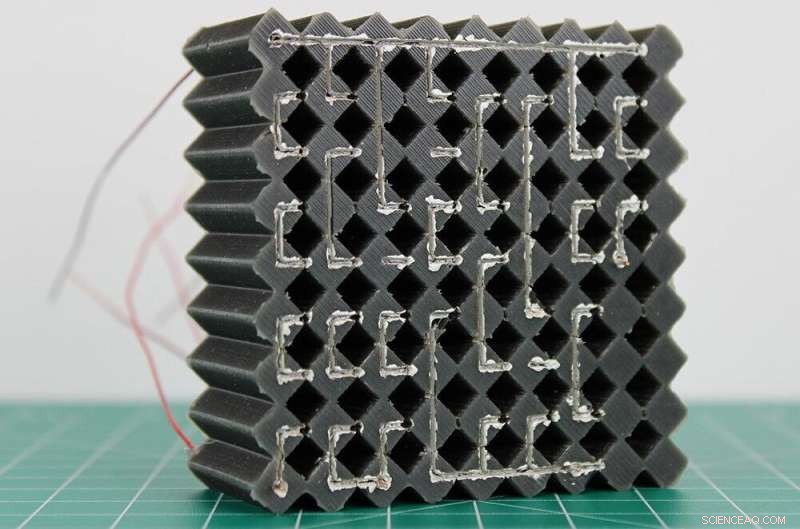
Un matériau de circuit intégré mécanique peut effectuer des tâches de calcul comme un ordinateur sans avoir besoin de l'ordinateur. Ici, l'exemple de matériau effectue des opérations arithmétiques, compare des nombres et convertit les informations numériques sous forme d'affichage LED. Crédit :Charles El Helou/État de Penn
Quelqu'un te tape sur l'épaule. Les récepteurs tactiles organisés dans votre peau envoient un message à votre cerveau, qui traite les informations et vous demande de regarder à gauche, dans la direction du robinet. Maintenant, les chercheurs de Penn State et de l'U.S. Air Force ont exploité ce traitement de l'information mécanique et l'ont intégré dans des matériaux techniques qui "pensent".
Le travail, publié aujourd'hui dans Nature , repose sur une nouvelle alternative reconfigurable aux circuits intégrés. Les circuits intégrés sont généralement composés de plusieurs composants électroniques logés sur un seul matériau semi-conducteur, généralement du silicium, et ils exécutent tous les types d'électronique moderne, y compris les téléphones, les voitures et les robots. Les circuits intégrés sont la réalisation par les scientifiques d'un traitement de l'information similaire au rôle du cerveau dans le corps humain. Selon le chercheur principal Ryan Harne, James F. Will Career Development Associate Professor of Mechanical Engineering à Penn State, les circuits intégrés sont le constituant central nécessaire au calcul évolutif des signaux et des informations, mais n'ont jamais été réalisés auparavant par des scientifiques dans une composition autre que le silicium. semi-conducteurs.
La découverte de son équipe a révélé la possibilité pour presque n'importe quel matériau qui nous entoure d'agir comme son propre circuit intégré :être capable de "penser" à ce qui se passe autour de lui.
"Nous avons créé le premier exemple d'un matériau d'ingénierie qui peut simultanément détecter, penser et agir sur les contraintes mécaniques sans nécessiter de circuits supplémentaires pour traiter ces signaux", a déclaré Harne. "Le matériau polymère souple agit comme un cerveau qui peut recevoir des chaînes d'informations numériques qui sont ensuite traitées, ce qui donne de nouvelles séquences d'informations numériques qui peuvent contrôler les réactions."
Le matériau mécanique souple et conducteur contient des circuits reconfigurables qui peuvent réaliser une logique combinatoire :lorsque le matériau reçoit des stimuli externes, il traduit l'entrée en informations électriques qui sont ensuite traitées pour créer des signaux de sortie. Le matériau pourrait utiliser la force mécanique pour calculer une arithmétique complexe, comme Harne et son équipe l'ont démontré, ou détecter des fréquences radio pour communiquer des signaux lumineux spécifiques, entre autres exemples de traduction potentiels. Les possibilités sont vastes, a déclaré Harne, car les circuits intégrés peuvent être programmés pour faire beaucoup.
"Nous avons découvert comment utiliser les mathématiques et la cinématique - comment les composants individuels d'un système se déplacent - dans les réseaux mécaniques-électriques", a déclaré Harne. "Cela nous a permis de réaliser une forme fondamentale d'intelligence dans les matériaux d'ingénierie en facilitant le traitement de l'information entièrement évolutif intrinsèque au système de matériaux souples."

Les matériaux de circuits intégrés mécaniques fabriqués à partir de matériaux en caoutchouc conducteurs et non conducteurs détectent et réagissent à la façon dont les forces leur sont appliquées. Crédit :Charles El Helou/État de Penn
According to Harne, the material uses a similar "thinking" process as humans and has potential applications in autonomous search-and-rescue systems, in infrastructure repairs and even in bio-hybrid materials that can identify, isolate and neutralize airborne pathogens.
"What makes humans smart is our means to observe and think about information we receive through our senses, reflecting on the relationship between that information and how we can react," Harne said.
While our reactions may seem automatic, the process requires nerves in the body to digitize the sensory information so that electrical signals can travel to the brain. The brain receives this informational sequence, assesses it and tells the body to react accordingly.
For materials to process and think about information in a similar way, they must perform the same intricate internal calculations, Harne said. When the researchers subject their engineered material to mechanical information—applied force that deforms the material—it digitizes the information to signals that its electrical network can advance and assess.
The process builds on the team's previous work developing a soft, mechanical metamaterial that could "think" about how forces are applied to it and respond via programmed reactions, detailed in Nature Communications last year. This earlier material was limited to only logic gates operating on binary input-output signals, according to Harne, and had no way to compute high-level logical operations that are central to integrated circuits.
The researchers were stuck, until they rediscovered a 1938 paper published by Claude E. Shannon, who later became known as the "father of information theory." Shannon described a way to create an integrated circuit by constructing mechanical-electrical switching networks that follow the laws of Boolean mathematics—the same binary logic gates Harne used previously.
"Ultimately, the semi-conductor industry did not adopt this method of making integrated circuits in the 1960s, opting instead to use a direct-assembly approach," Harne said. "Shannon's mathematically grounded design philosophy was lost to the sands of time, so, when we read the paper, we were astounded that our preliminary work exactly realized Shannon's vision."
However, Shannon's work was hypothetical, produced nearly 30 years before integrated circuits were developed, and did not address how to scale the networks.
"We made considerable modifications to Shannon's design philosophy in order for our mechanical-electrical networks to comply to the reality of integrated circuit assembly rules," Harne said. "We leapt off our core logic gate design philosophy from the 2021 research and fully synchronized the design principles to those articulated by Shannon to ultimately yield mechanical integrated circuit materials—the effective brain of artificial matter."
The researchers are now evolving the material to process visual information like it does physical signals.
"We are currently translating this to a means of 'seeing' to augment the sense of 'touching' we have presently created," Harne said. "Our goal is to develop a material that demonstrates autonomous navigation through an environment by seeing signs, following them and maneuvering out of the way of adverse mechanical force, such as something stepping on it."
Other authors of the paper include Charles El Helou, doctoral student in mechanical engineering at Penn State, and Benjamin Grossman, Christopher E. Tabor and Philip R. Buskohl from the U.S. Air Force Research Laboratory. A future of helpful engineered 'living' machines?